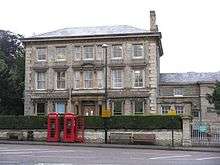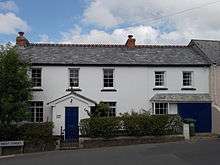Mary Norton (author)
| Mary Norton | |
|---|---|
 'The Cedars', Norton's house until 1921 and reportedly the setting of The Borrowers | |
| Born |
Kathleen Mary Pearson 10 December 1903 London, England, UK |
| Died |
29 August 1992 (aged 88) Bideford, Devon, UK |
| Occupation | Writer |
| Nationality | British |
| Genre | Children's fantasy novels |
| Notable works |
|
| Notable awards |
Carnegie Medal 1952 |
Mary Norton, or Kathleen Mary Norton née Pearson (10 December 1903 – 29 August 1992), was an English author of children's books.[1] She is best known for the The Borrowers series of low fantasy novels (1952 to 1982), which is named after its first book and, in turn, the tiny people who live secretly in the midst of contemporary human civilisation.
Norton won the 1952 Carnegie Medal from the Library Association, recognising The Borrowers as the year's outstanding children's book by a British subject.[2] For the 70th anniversary of the Medal in 2007 it was named one of the top ten winning works, selected by a panel to compose the ballot for a public election of the all-time favourite.[3][lower-alpha 1]
Life
Kathleen Mary Pearson was the daughter of a physician and was raised in a Georgian house at the end of the High Street in Leighton Buzzard. The house now forms part of Leighton Middle School, known within the school as The Old House, and was reportedly the setting of her novel The Borrowers. She married Robert Charles Norton on 4 September 1927 and had four children, two boys and two girls; her son Robert became a printer and consultant for Microsoft.[4][5] Her second husband was Lionel Bonsey, whom she married in 1970.[1] She began working for the War Office in 1940 before the family moved temporarily to the United States. She began writing while working for the British Purchasing Commission in New York City during the Second World War. Her first book was The Magic Bed Knob; or, How to Become a Witch in Ten Easy Lessons, published by J. M. Dent in 1943.[6] Its sequel Bonfires and Broomsticks followed two years later and they were re-issued jointly as Bed-Knob and Broomstick in 1957. The stories became the basis for the 1971 Disney film Bedknobs and Broomsticks. Norton died of a stroke in Bideford, Devon, England on 29 August 1992.
Works

All of these books save for The Borrowers Avenged were originally published by J. M. Dent in hardcover editions.[6]
- The Magic Bed Knob (1945)
- Bonfires and Broomsticks (1947)
The first omnibus edition was Bed-Knob and Broomstick (1957), illustrated by Erik Blegvad; later Bedknobs and Broomsticks after the Disney film (see adaptations).
- The Borrowers (1952) — winner of the Carnegie Medal[2]
- The Borrowers Afield (1955)
- The Borrowers Afloat (1959) — a Carnegie runner-up[lower-alpha 1]
- The Borrowers Aloft (1961)
- Poor Stainless: A New Story About the Borrowers (1966)[6]
- Are All the Giants Dead? (1975) — no relation to the Borrowers series[7]
- The Borrowers Avenged (Viking Kestrel 1982)
- The Complete Borrowers Stories (omnibus, excluding Poor Stainless, issued with an introduction by the author) (1983)
- Poor Stainless (revised as a novelette with a short author's note) (1994) (Viking UK, 0-670-85427-1).[8]
The Borrowers novels have been illustrated by Diana Stanley and Ilon Wikland.
- The Bread and Butter Stories (1998) - a collection of short stories for adults, written for magazines.
Film, TV and theatrical adaptations
“Do not stand at my grave and weep,
I am not there. I do not sleep.
I am a thousand winds that blow.
I am the diamond glints on snow.
I am the sunlight on ripened grain.
I am the gentle autumnal rain.
Do not stand at my grave and cry;
I am not there. I did not die.”
(Extract from a poem by Mary Elizabeth Frye.)
Norton's novels The Magic Bed Knob; or, How to Become a Witch in Ten Easy Lessons and Bonfires and Broomsticks were adapted into the 1971 Disney film Bedknobs and Broomsticks, starring Angela Lansbury and David Tomlinson.
There have been several screen adaptations of The Borrowers:
- The Borrowers: a 1973 American made-for-TV movie.
- The Borrowers: a 1992 BBC TV series and its 1993 sequel The Return of the Borrowers, both starring Ian Holm and Penelope Wilton.
- The Borrowers: a 1997 film with a British/American cast including Tom Felton, John Goodman, Jim Broadbent, Celia Imrie and Mark Williams.
- The Secret World of Arrietty: a 2010 Japanese animated film from Studio Ghibli.
- The Borrowers: a 2011 British film starring Stephen Fry, Victoria Wood and Christopher Eccleston.
There have also been numerous theatrical adaptations of The Borrowers.[9][10]
Notes
- 1 2 Today there are usually eight books on the Carnegie shortlist. The Borrowers Afloat, third in the series, was one of five "Commended" runners-up for the 1959 Medal. The distinction was used about 160 times from 1954 to 2002, counting both commendation and high commendation in later years.
"Carnegie Medal Award". 2007(?). Curriculum Lab. Elihu Burritt Library. Central Connecticut State University. Retrieved 2012-07-10.
References
- 1 2 "Mary Norton." St. James Guide to Children's Writers, 5th ed. St. James Press, 1999.
- 1 2 (Carnegie Winner 1952). Living Archive: Celebrating the Carnegie and Greenaway Winners. CILIP. Retrieved 2012-07-10.
- ↑ "70 Years Celebration: Anniversary Top Tens". The CILIP Carnegie & Kate Greenaway Children's Book Awards. CILIP. Retrieved 2012-07-10.
- ↑ Barker, Nicolas. "Robert Norton - obituary". The Independent. Archived from the original on 23 June 2001. Retrieved 11 May 2016.
- ↑ Berry, John. "The Mischievous Mind behind Microsoft's TrueType Fonts". Creative Pro. Retrieved 11 May 2016.
- 1 2 3 "Mary Norton Bibliography: A Collectors Reference Guide: UK First Edition Books". Bookseller World. Retrieved 2012-07-10.
- ↑ "Are all the giants dead?" (first US edition). WorldCat. Retrieved 2013-07-03.
- ↑ Poor Stainless (collection) publication contents at the Internet Speculative Fiction Database. Retrieved 2012-07-10.
- ↑ Anne Hopper (3 December 2007). "The Borrowers". TheStage.co.uk. Retrieved 2011-08-22.
- ↑ Kelly Rowles (5 November 2010). "Philly's Arden Theatre Brings The Borrowers to the Stage this December!". CultureMob. Retrieved 2011-08-22.
External links
- Mary Norton at the Internet Speculative Fiction Database
- Mary Norton at Library of Congress Authorities, with 44 catalogue records